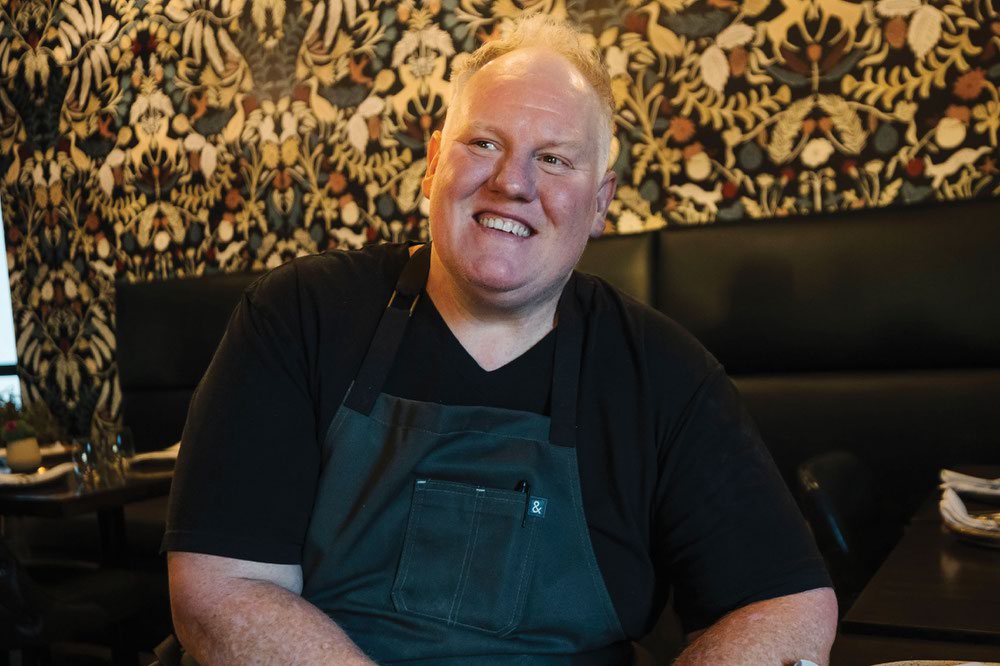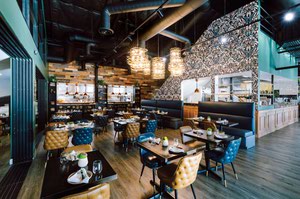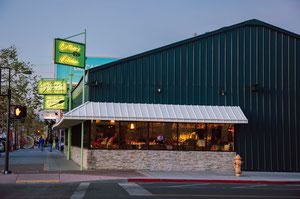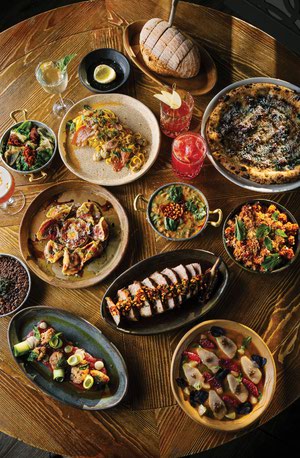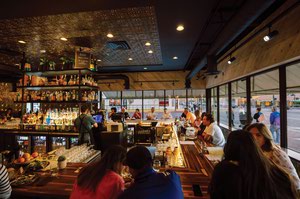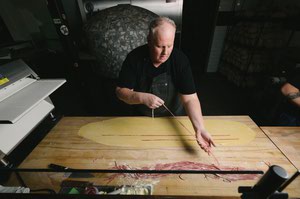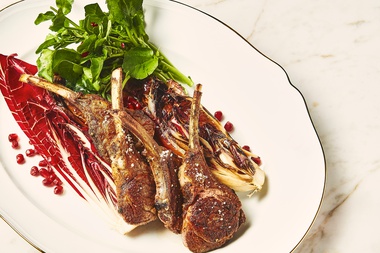I never wanted to own a restaurant,” James Trees says.
Really?
“Oh, yeah. I always thought that the way to be successful in this business was to get paid a lot of money for your opinion. That’s what Michael Mina does, right? He doesn’t have to operate his restaurants day-to-day.”
Trees knows he’s skirting irony in saying that. For one thing, he has three Valley restaurants to his name—the wildly popular Arts District destination Esther’s Kitchen, and two Lev Group co-ventures in the Summerlin-adjacent Tivoli Village, Ada’s Food + Wine and Al Solito Posto—and there are more on the way. And while his opinion is demonstrably valuable, it’s hard to believe that Trees could avoid the kitchen for any length of time. He loves it too much for that.
“Hey, you want to see the kitchen?” he asks. We walk through the new, vastly expanded Esther’s, located on Main Street inside the space that formerly belonged to antique dealer Retro Vegas. Trees extended the already spacious building, adding more back of house space and guest bathrooms, bringing the square footage up to nearly 11,000—roughly five times larger than the original Esther’s location on California Avenue. The dining room is now big enough to accommodate the crush of locals and visitors booking tables at Esther’s nightly; the bar area big enough to take walk-ins. A private dining room can be quickly created by closing a wall of glass doors. They’ve even added a luggage storage room to accommodate airport-bound guests.
Once in the kitchen, Trees points out its numerous upgrades, which include larger prep areas, a high-capacity dish station and an impressive bread oven that will produce loaves not just for Esther’s but his other restaurants as well. (It’s not yet operational at the time of our interview; Trees calls it “an $85,000 paperweight.”) He raves about the wood fire hearth, custom-built by Gary Knackstedt of NorCal Ovenworks, like he’s talking up a new Lexus sedan.
“Everything that we did in this space was to solve a problem,” he says. “The bar is now the size it should be for the guest count that we have. Our tables are much more stretched out; we don’t need to jam 70 seats into a small space. We don’t have to stack the kitchen with a ton of tickets, because now we can progress throughout the night using tables two times instead of four times. That’s the idea with everything that we’ve done here.”
One problem-solving element he doesn’t have to point out is the crew, which is working that brand-new kitchen as if it’s always existed. Trees offers gentle high-fives to nearly everyone who doesn’t have their hands full. He thanks everyone profusely, often adding, “I appreciate you.” And when crew members approach him with questions or updates they’re bursting with enthusiasm, like they’re about to relay the best news he’s ever heard.
For Trees, it’s evident that the news is great across the board. Since opening in January 2018, his seasonal Italian restaurant has become a local institution so beloved it had to more than quadruple in size to squeeze in all its fans. It has an artful look, conceived by his sister Amanda, that’s wholly becoming to its neighborhood. And it’s staffed by people who excel at what they do and have an earned, unwavering faith in the boss.
“We have a lot of pros here that already kind of know what they’re doing, so [Trees] has a lot of trust in myself, my front of house team, Chef Dylan [Jobsz], Chef Sean [O’Hara] and everybody in the back,” says Keith Bracewell, Trees’ director of operations. “Our goal is to get him to not be here all the time. … I don’t want him managing. I want him doing what he’s passionate about doing, allowing him more time to be creative. I want him to go around the room and talk to people—shake hands, kiss babies, maybe have a glass of wine—and enjoy it. People gravitate to him, because he is that guy.”
THE BEST JOB IN THE WORLD
“We come from an education background on my mom’s side, who was very into education: You had to go to college,” Amanda Trees says. “And a creative background on my dad’s side, who was a musician our whole lives and didn’t have his first job until he was 50 [laughs]. She was probably scared of us doing our creative side. But she was very supportive when she realized that you could have success without a lot of education.”
James Trees’ CV has some schooling in it, but it quickly gives way to working kitchens. He began cooking at Las Vegas High School and earned an internship at the Mirage after just two years of training. He attended the Culinary Institute of America in Hyde Park, New York, and went on to work under such big-name chefs as Bradley Ogden, Luke Palladino, Eric Ripert, Jacques Van Staden, and, yes, Michael Mina, for whom he opened five restaurants.
He appeared on Gordon Ramsay’s Kitchen Nightmares until he began to miss being in the kitchen, taking the chef de cuisine position at Ray Garcia’s farm-to-table spot Fig in Santa Monica and working with several other prominent LA chefs. It was a good time for him.
“I had the best job in the world; I was a corporate chef in Venice, California. I got to run Pitfire Pizza and Superba [bakery] with Paul Hibler, and I was livin’ the dream, walking on the beach seven days a week,” he says. “But I saw a monumental shift in the kind of person who was moving to Las Vegas.”
Trees loves his hometown with a passion and has a longtime local’s understanding of what it wants and needs. He’s prickly about large-scale events like Formula 1 (“When people come in and use our town the way someone like that did, it’s offensive to me”) and has an abiding respect for the brand of hospitality Vegas was built on. In fact, he abandoned projects at two Strip hotels because “their philosophy on hospitality and my philosophy on hospitality were so far apart, that it didn’t make sense to continue.”
And during those visits back home—for pop-ups, for holidays, to visit with his sister—Trees saw that Vegas was becoming “less transient” in nature. Increasingly, its residents were putting down permanent roots.
Trees intuited that Las Vegans were ready for the kind of dining he knew in LA—neighborhood spots with relaxed vibes, and with kitchens that drew their ingredients from family-run ranches and farms. He looked to the Arts District, which already had such burgeoning neighborhood-focused businesses as Makers & Finders, Vesta Coffee Roasters and Makeshift Union, and decided to open Esther’s Kitchen there, in the corner space of a renovated hotel, in early 2018.
Esther’s, named for Trees’ great aunt, was run by some of Trees’ oldest friends and young, hungry talents like Bracewell. It immediately established itself as a praiseworthy spot—not just for the Arts District, but for the Valley as a whole. Esther’s served up housemade polenta with truffle butter and sherry, ricotta gnudi with whole beets and pistachio pesto, and cacio e pepe with housemade chitarra and tossed with pecorino and Tellicherry peppercorns. And every meal could begin with outstanding cocktails and fresh sourdough bread, which the author of this piece always orders with fresh burrata and always will.
Despite raves from guests and some significant national recognition—Trees was nominated for a James Beard Award in 2020—the success of Esther’s was never completely assured. Road work on California Avenue resulted in reduced parking and dirt sidewalks in front of Esther’s for more than a year. And the COVID pandemic shutdowns of 2020 forced Trees to reducehis staff, save for a small kitchen crew—who kept themselves occupied by baking sourdough loaves, which Trees offered to his Downtown neighbors free of charge.
“What’s crazy about that is that people refused to not give us money for [the bread]. We started bringing back staff members because of that, and those little to-go dinners. By the time we were allowed to open, we already had like 60% or 70% of our kitchen staff back to work.”
He adds that no one working at Esther’s during the pandemic took a pay cut or lost their benefits. “I would have rather gone out of business than have had to tell them they can’t pay their rent. All the undue burden that would have caused them so that, what, I can have couple extra bucks in the bank?”
Bracewell, who first transitioned into a management role at Esther’s during the shutdown, says the care and integrity Trees showed during the pandemic is part and parcel of what makes Esther’s such a success.
“James and I have kind of a different relationship than I’ve had with a lot of the owners that I’ve worked for,” Bracewell says. “He really takes care of his staff. He means what he says, and he executes on a higher level, and he just holds everybody accountable and to a higher standard. I think that excellence shows in how busy we are and, obviously, it’s represented in the food.”
It also shows clear across town, at Trees’ two Tivoli Village establishments. As reservations at Esther’s became harder to get, my girlfriend and I would often go to Al Solito Posto, which doesn’t have the same relaxed, cozy LA vibe as Esther’s—kind of impossible to pull off in a space formerly occupied by a chain restaurant—but it feels nice, in any case, and the food is excellent.
I tell Trees a story about the first time we visited Al Solito Posto, in spring 2021: Our server made a miniscule error, and before we’d even noticed it, the server appeared at our table with a complimentary bottle of wine. Good stuff, too.
“You’re talking about a case of empowerment,” Trees says, explaining that likes to find workers who are disillusioned with working in restaurants on the Strip—where an 8-hour day balloons to 11 hours thanks to gridlock resort corridor traffic, checking out a uniform, mandated break times and traversing casino floors bigger than football fields.
“I find people who are in love with this business. I find out what they like to do. I like to make sure that they’re at the top of their game. And then we build them up by empowering them, like your server. … So many things in this world are complicated. Restaurants are easy. I tell all my servers now that if something’s wrong on the table, fix it. I tell them, ‘It’s your job to make people love this restaurant and make it their favorite restaurant of all time.’”
At that, I mention how much I enjoyed a recent visit to Ada’s, partially because of its terrific food, wine and servers, but mostly because their lead sommelier, Kat Thomas, is a hoot-and-a-half. Every time she brought a new bottle to the table, she’d describe it in the richest possible terms—its taste, its provenance, even the meaning of its label—and punctuate the description with something irreverent: “This one’s gonna slap you around the mouth a little bit.”
“She ought to have a fan club,” I suggest.
“Oh, she does,” Trees says.
ROOM AT THE BAR
The new Esther’s opened its doors on Friday, March 8. Due to a postponement caused by high winds, it’s also First Friday in the Arts District, so I try to get to the restaurant as early as I can after work. It is, predictably, booked solid. I have no reservation, but thanks to a friendly (empowered!) host, I get a seat at the bar for two hours, which is just what I need.
Almost immediately I see people I know, locals who have supported Esther’s from day one. I order a cocktail, a loaf of sourdough with burrata and a radiatore in a tripe sauce, which is splendid. Artist Jerry Misko wanders over, wine in hand, to inform me that he has new paintings hanging in Esther’s bathrooms; I check and sure enough, he does.
The hallway leading to those bathrooms is wrapped in a collage of menus from Esther’s past, a medley of dishes and drinks that have come and gone with the seasons. When I return to my spot at the bar, I carefully roll up my menu and put it in my bag, knowing that it might all change in a week, or even tomorrow.
Looking at Esther’s in the context of First Friday really makes me appreciate Amanda Trees’ contributions even more. The glassed-in pasta-making station puts one of the most interesting parts of the kitchen front and center (and reminds me of a similar arrangement at Chinatown’s Shanghai Taste, also a favorite of Chef Trees.) The bar has a panoramic view of Main and California, thanks to an additional pair of windows Amanda insisted on adding to the property’s south side. And the wall wraps, by ColorUp’s Vinni LaPadula, are busy in just the right way; the eye tries to process them for a second, then says, Y’know, I’m just gonna go with it.
“I did take my time coming up with the details,” she says. “When they were trying to rush me—‘What is this? What color stain do you want on this wainscoting?’—I was like, ‘Okay, we’ll try this one; nope, too dark.’ You know what I mean? I made sure that everything was basically exactly how I wanted it.”
That perfectionism is a family trait, Bracewell says.
“When the chefs put out a dish, [James] says, ‘Make it for me.’ And then they workshop it together. Sometimes it’s great, and he says, ‘That’s perfect, put it out.’ Sometimes it’s not, and we’ve got to put it back on the board and restructure it. If we have to scrap it, we scrap it.
“I’ll be honest with you: As creative as everyone is, I’ve honestly not seen anyone as dedicated, except for maybe Raphael Lunetta, who I worked for at JiRaffe in Santa Monica. When James touches a dish you’re just like, wow. Okay, yeah, that makes sense. It’s like Picasso: It was really good before, and now, ‘Oh, holy sh*t.’”
Now, James Trees is concerned with bettering Esther’s as a whole. There are still parts of the space that are incomplete: An intimate loft cocktail bar called the Bird’s Nest, and the back patio, which Trees intends to use for a weekend farmer’s market and other events. In fact, he’s thinking of the entire neighborhood surrounding Esther’s, which will soon be home to several more of his ventures—including a French restaurant called Bar Bohème with an adjoining bar called Petit Bohème; a high-priced, reservation-only tasting menu restaurant, located in the former Esther’s space; and some other stuff he doesn’t want to talk about just yet.
But his greatest Arts District concern is holding onto what drew him to the neighborhood in the first place. From the day Esther’s opened, they’ve served on plates made by Clay Arts Vegas, which used to be just up Main Street in the building now occupied by Wiseguys Comedy Club. Clay Arts Vegas, like many other art galleries and arts business, is no longer located in the Arts District, and that doesn’t sit easy with a hardcore local Las Vegan like Trees.
“The development of the Arts District, unfortunately, has come at the detriment of artists,” he says. “And it’s something that we want to fix. On First Fridays we’re going to start having a gallery space out on our patio. This was the original heart of First Friday, and we want to bring it back. We want to give people these spaces, opportunities to have something that they had before, rather than the neighborhood just forcing them out, out, out. I really love this neighborhood, and I don’t want it to lose everything that made it special. …
“It’s an amazing time to be an entrepreneur in Las Vegas, and in running restaurants. But these moments are fleeting. We need to make sure we take advantage of it, and make sure that everyone is able to grow, to continue to move up and to do all the things they want to do.”
Click HERE to subscribe for free to the Weekly Fix, the digital edition of Las Vegas Weekly! Stay up to date with the latest on Las Vegas concerts, shows, restaurants, bars and more, sent directly to your inbox!
